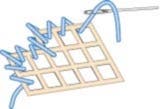How to Overcast
Overcasting is used to cover the raw edges on a single piece of plastic canvas.
To overcast, work one stitch in each hole along straight edges and in inside corners, and two or three stitches in outside corners for complete coverage. Overcast stitches are always worked in the same direction which creates a series of diagonal stitches that nicely wraps around and covers the raw edge of the canvas. Overcasting is done as the final finishing step of a project. Note that overcasting is worked on a single sheet of canvas. When you join two pieces of canvas together, you will use the Whipstitch technique.
- After your plastic canvas design is stitched, bring your threaded needle up through the canvas from back to front in one of the top holes along the project edge. Leave a 1-inch tail.
- Insert needle from back to front in the hole adjacent to the beginning hole. The yarn will naturally wrap around the plastic canvas.
- Continue stitching from back to front keeping stitches even and diagonal. Don’t pull the stitches so tight that you can see the canvas between the stitches.
- When you reach a corner, work 2-3 stitches in the corner for full coverage of the plastic canvas. Hint: Carefully trim the sharp edge off the corner with a pair of fine-tip scissors being careful to avoid cutting into the hole. A less sharp corner will allow your yarn to cover the canvas more easily.
- When finished, run the yarn end under an inch or so of stitches on the back side of your work to secure.


